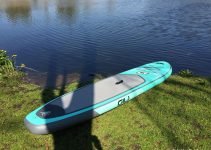As an Amazon Associate, I earn from qualifying purchases. This is without any additional costs for the buyer but does support me in maintaining my website.
Whether you own an inflatable kayak, dinghy, raft, pontoon boat or float tube, you will have to dry them to avoid mold. A common mistake beginners do is to dry their inflatable improperly, which often leads to mold buildup.
The first step to keeping your inflatable healthy is to dry it properly, if you fail to do so, it’s more than likely that mold will start appear here and there. Not only does it smell bad, it will ruin your boat! We’re usually pretty picky about drying our boats, we remove all the sand and gravel from them but we also make sure they’re 100% dry. We don’t want to leave any moisture.
The Proper Way
To dry it properly you’ll need at least two towels, bring more if you have a larger boat. If you have the time, let it air dry for a while before you begin using your towels.
While it is still inflated, remove all the accessories from it, things like seats, extra bags, floors and so on. When finished you should be left with just the hull of the boat. Next take your towels and make sure to dry all of the outer surfaces. When you feel that the outer hull cannot get any drier, it’s time to move onto the next step.
Next up you’ll want to deflate the floor (If you have an inflatable floor that is) and tip your inflatable sideways or turn it completely upside down, this will help drain any excess water that has built up inside. Bring out your towels once again and make sure to dry all the areas as good as you possibly can. During step you can also use the towels to clean out any sand or gravel that you find. Don’t worry if you cannot get it all out, as long as it’s dry it’s not a problem.
Third step is to deflate the rest of the boat, continue to use your towels to soak up all the water and moisture. If possible, switch to a completely dry towel to avoid any more moisture buildup. Roll it up and make sure to wipe of any water as you roll it.
The Lazy Way
Not recommended if you truly care about your inflatable, but we know that sometimes you just want to relax and let the sun do the work for you. The problem when letting the sun do all the work for you is that the sun won’t dry those hard to get areas, those creases and small corners can be really sneaky and will eventually start to mold.
Keep it inflated until the outer hull is completely dry, flip it over and repeat the process.
If possible deflate it completely and try it lay out to get some sun light into those sneaky creases and corners.
This takes a lot more time, especially on cloudy days, but hey, at least you don’t have to dry it yourself.
Just how dry does it need to be?
Do you really need to dry as thoroughly as we described? No, absolutely not. But the question is whether you rather have an inflatable that lasts a couple of years or if you want to keep buying new ones because mold keeps eating away the fabric.
If you use your boat at least once a week, then it doesn’t really need to be super dry, but if you want to ensure that your boat is 100% mold free, we do recommend cleaning it as thorough as possible. It’s better to be safe than sorry, right? Don’t worry if about gravel and sand, it’s inevitable to get all of it out of the boat.
If for some reason you just cannot dry those creases with a towel, take the inflatable home and hit it with a hair dryer, just make sure to keep the temperature low and not hold against a spot for too long. Keeping it at a high temperature for longer periods of time increases the risk of burning the fabric.
Another thing to keep in mind is that different inflatables have different drying times. An inflatable made out of cheap PVC will obviously be easy to dry since there’s not any fabric that will absorb the water.


